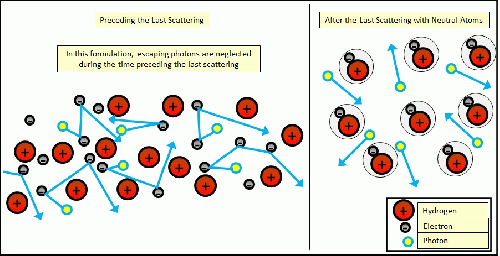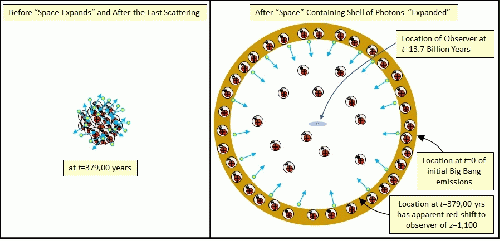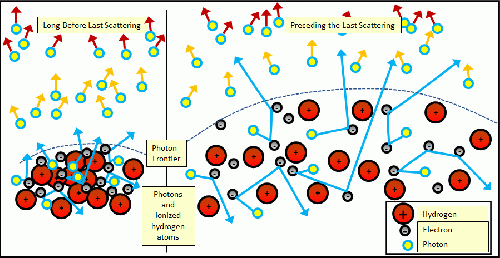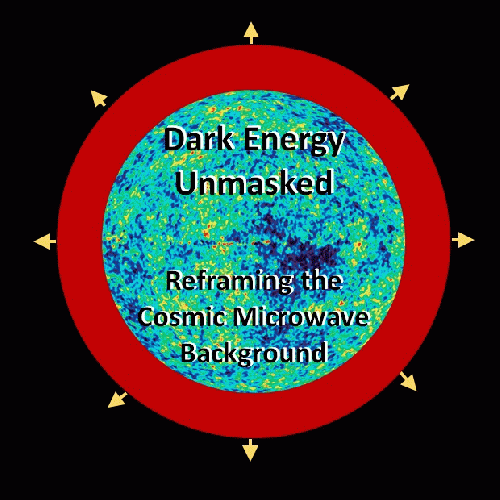| Back OpEd News | |||||||
|
Original Content at https://www.opednews.com/articles/Dark-Energy-Unmasked-Refr-by-Wayne-Coste-Beginning-Of-The-Universe_Cosmic-Evolution_Cosmic-Microwave-Background_Cosmic-Web-210725-541.html (Note: You can view every article as one long page if you sign up as an Advocate Member, or higher). |
|||||||
July 25, 2021
Dark Energy Unmasked: Reframing the Cosmic Microwave Background
By Wayne Coste
Since its discovery in the last century, the Cosmic Microwave Background (CMB) has been explained as the fossil remnant of the energy from a time shortly after the Big Bang. The microwave radiation of the CMB is explained as a result of the wavelengths being stretched as space, itself, expanded. This requires space to expand - violating conservation of energy. Extending the GRSGM hypothesis provides a concise alternative.
::::::::
A mechanism explaining how the Universe could be expanding at an accelerating rate was hypothesized in a previous article in this series. It provided a hypothesis based on known laws of physics and provides an elegant solution to that observed phenomenon without resorting to unexplainable phenomenon, such as Dark Energy. This article will address the cosmic microwave background (CMB) and discuss how the prevailing explanation may be reinterpreted in light of the aforementioned hypothesis.In its simplest terms, that hypothesis states the Big Bang resulted in an enormous amount of radiant energy that, according to Einstein's Equation, would have been elastically linked to all other matter, energy, momentum, pressure and tension in the entire Universe. It is widely believed that the Universe, in its earliest moments, was dominated by radiant energy but the implications have been overlooked. This elastic linkage between the matter in the observable universe and the outward-bound radiant energy creates the dual phenomenon that simultaneously extracts energy from the outgoing radiant energy and exerts a gravitational attraction on the matter which then accelerates outward. This extraction of energy from the outgoing radiant energy results in the red-shifting of the radiant energy's wavelength - which means lower energy. Recognizing the comprehensive and interrelated effect of both the outward-bound energy and acceleration of the inertial mass of the observable energy was referred to as the Gravitational Red Shifted Gravity Moat (GRSGM) hypothesis in the previous article.
It was posited that the only counterargument to the GRSGM hypothesis that seemed applicable was that "there cannot be that much gravitational effect from energy radiated during, and in the aftermath of, the Big Bang". While the relative amounts of energy in the sphere of the radiated energy inducing the GRSGM vis-Ã -vis the amount of energy, mass, momentum, pressure and tension in the observable Universe is unknown, the expectation that radiated energy dominated the Big Bang and the moments afterwards is central to nucleosynthesis - which describes the formation of hydrogen, helium and trace amounts of lithium in the aftermath of the Big Bang.
Given the meager ability of current particle accelerators to create matter from energy, it is not unreasonable to hypothesize that, even in the cauldron of energy brought-forth in the Big Bang, that a relatively small proportion of the total energy was expended in the creation of known particles and that a larger fraction of the energy would have been dispersed as radiated energy - with its subsequent, and not insignificant, linked gravitational effect on the matter in the observable Universe.
Importantly, the GRSGM hypothesis explicitly incorporates momentum from an initial radial velocity as a key component influencing the dynamics of the expanding Universe. Under this framework, the inter-related dynamics of an initial velocity, the gravitational pull induced by the GRSGM hypothesis and the gravitational attraction of matter could provide the basis for an explanation for a changing rate of acceleration in the observable Universe as the gravitational attraction of matter-to-matter decreases with increasing separation.
Since its discovery in the last century, the CMB phenomenon has been explained as the fossil remnant of the energy from a very specific period of time shortly after the Big Bang. The microwave radiation of the CMB is explained as the result of wavelengths of radiant energy being emitted from a compact Universe radiating as a black body at 3,000 degrees Kelvin then those wavelengths being stretched as space, itself, expanded by a factor of 1,100. This requires space to expand which appears to violate conservation of energy in the broadest sense and an alternative explanation that does not violate the conservation of energy principle would be preferable.
Explanation of Red-Shift
Because the concept of observed red-shift of radiant energy from objects is central to a discussion of the CMB, the following explanation provides a basis for understanding the phenomenon.
Based on an analysis of a spectrum of light from a distant object, the wavelength vs. amplitude of radiant energy can be determined. In that spectrum, emission or absorption lines of specific elements can be observed. By comparing the emission or absorption lines from a stationary laboratory test to the observed spectrum, a red shift can be calculated using the following formula:
Redshift z = (λobserved - λrest) / λrest
For example, if the red-shift doubled the wavelength from "x" to "2x" due to either the expansion of space, itself, or due to a kinematic doppler effect (e.g., classical concept of relative motion), the redshift would be calculated as follows:
Redshift z= (2x - x) / x
Redshift z = 1*x/x
Redshift z = 1.0
The most distant galaxies that have been observed have a red-shift of approximately 10, which means the characteristic emissions lines have been stretched to wavelengths that are 10 times longer than they would be in a laboratory experiment. As will be discussed, the redshift for the CMB is about two orders of magnitude larger than the redshift of the most distant galaxies and has been calculated to be approximately z = 1,100.
While these are all considered to be redshifts, the CMB redshift does not contain any identifiable emission or absorption lines to use in the previous formula. Rather the z = 1,100 redshift is the ratio of the dominant emission peak of a black-body at 3,000 degrees Kelvin vs. the dominant emission peak of the CMB at radiating as a black body at 2.7 degrees Kelvin.
Cosmic Microwave Background (CMB)
The widespread conceptualization of the origin of the CMB phenomenon is shown in Figure 1. Based on well-known physical processes related to plasmas - gas clouds are opaque to the passage of photons when temperatures are above 3,000 degrees Kelvin because photons cannot avoid being reflected by ionized atomic particles. In this manner, it has been assumed that photons and radiated energy were trapped in a hot, opaque, ionized fog as shown on the left side of Figure 1. As the Universe cooled, the hydrogen nuclei and electrons coalesced into neutral atoms during the process known as recombination or, the "last scattering", as shown on the right side of the Figure 1.

Figure 1: The standard explanation for the origin of the Cosmic Microwave Background is that, upon recombination, photons were no longer scattered by ionized matter and the Universe became transparent allowing photons to travel unimpeded.
(Image by Wayne H. Coste, BS-EE, PE, IEEE-SM) Details DMCA
Recombination allowed the photons to travel relatively unimpeded out into the Universe as the hot, ionized fog became transparent. Consequently, the photons traveled in the direction that they were heading at the moment the Universe became transparent. The left side of Figure 2 (which is equivalent to the right side of Figure 1) shows a zoomed-out version of the last scattering with neutral atoms. The photons are shown mostly traveling internally through the newly transparent sea of particles. In actuality, the photons would be traveling in all possible directions. On the right side of Figure 2, the sea of particles is shown as just a ring with the observer (and supposedly the rest of the observable Universe) somewhere in the interior. In textbook explanations, the ring was formed by space expanding so quickly via "cosmic inflation" that the photons of the last scattering are still heading toward the observer who would be, apparently, somewhere in the midst of that sea of particles. For illustration purposes the observer is assumed to be on the Earth and located in the Milky Way and near the center of the sphere.

Figure 2: Textbook explanations of the CMB say that at 379.000 years following the Big Bang the photons could pass through neutral atoms. Once space expanded, the photons continued toward our instruments, but with their wavelengths stretched by a factor o
(Image by Wayne H. Coste, BS-EE, PE, IEEE-SM) Details DMCA
Under this hypothesis, the CMB is an artifact of the effect that was estimated to have occurred approximately 379,000 years after the Big-Bang. Under this construct, these primordial fossil photons have been traveling toward earth for 13.7 billion years and those that have reached us have finally covered the initial separation distance of 0.0004 to 0.0008 billion light years. These tiny fractions of a billon years are based on the assumed radius of the Universe at the time of the last scattering and the maximum distance between any two points at that time. It is assumed that the hot ionized fog would have been that size - at give-or-take a few orders of magnitude. It is widely explained that the reason the radiated energy took so many billions of years to travel such a relatively "short" distance was because space was expanding at a high fraction of the speed of light. In other words, the electromagnetic waves that are being observed by our instruments today are the waves that were directed inward into what is now the observable Universe from the distant ring shown on right side of Figure 2.
The right side of Figure 2 shows neutral atoms in the outer shell in addition to the photons of the last scattering. If space is what was expanding, all of the particles in that portion of space would have expanded alongside the photons also, due to their simultaneous genesis and co-location in the Big Bang singularity just a "short time" before. Additionally, assuming that the hot, ionized cloud of particles was homogeneous and isotropic the "expansion of space" to create the CMB sphere would mean that the particles that would form the Milky Way galaxy would have been somewhere in the interior of that sea of particles. Additionally, that would mean there would be a continuum of particles and photons all the way out to the CMB with red-shifts of the wavelengths increasing from z=0 up to z=1,100. Under this explanation, the CMB radiation should have counter parts at all other distances to the observer. Such a continuous effect would make the spectrum from the CMB unremarkable due to all the other similar layers toward the interior.
The left side of Figure 3 shows the conceptual example where the emitted radiated energy from the last scattering (see position "A") had a specific wavelength when the plasma temperature had cooled to the range of 3,000 degrees Kelvin. Under the prevailing theories, the wavelength was stretched through the expansion of space alone as shown on the right side of Figure 3.

Figure 3: When electro-magnetic waves are emitted, they have a characteristic wavelength based on its energy. Under the prevailing CMB explanation, the wavelength of the CMB radiation was stretched as space, itself, expanded.
(Image by Wayne H. Coste, BS-EE, PE, IEEE-SM) Details DMCA
Because of this observed continuous connection with the photons of the CMB, the prevailing explanation suggests that we should be able to sense the presence of primordial galaxies with red shifts out to z=1,100. Under this construct, all radiation-emitting objects within the Universe should have a light path connecting each source and our instruments to, at least, the microwave range.
However, the most distant galaxies that have been observed are on the order of 10 while the redshift for the cosmic background radiation is two orders of magnitude higher, at about 1,100.
GRSGM and the CMB
An alternative explanation for the source of the CMB may be hypothesized as the radiation originating with the Big-Bang including the time before recombination (e.g., the last scattering) and continuing up to the present. Figure 4 shows a revised characterization of the physics during the time before recombination in which a significant amount of the energy was radiated outward at very high energies. This emission of radiation at very high energies was most intense in the immediate aftermath of the Big Bang and would have created a continuous stream of photons that escaped outward from the leading edge of the expanding hot ionized fog. Photons escaping from the leading edge would not be affected by whether the ionized fog behind was opaque or not.

Figure 4: For the entire time before the Last Scattering, photons have been emitted outside the expansion of the fermions comprising the primordial protons and electrons. Note that the electrons are continually scattered in off-radial directions
(Image by Wayne H. Coste, BS-EE, PE, IEEE-SM) Details DMCA
However, consistent with the dynamics prior to recombination, the direction of the photons would not only be radial, but could also be nearly parallel to the photon frontier. The off-radial photon trajectories prior to recombination could be a source of transverse photons that would then cause interference and also create impacts with other photons within the streams of outgoing radiation and thus they would have an effect on the outgoing radiation which could lead to the formation of what we now call the CMB.
During the primordial nucleosynthesis, high energy photon-photon collisions were responsible for the creation of particle-antiparticle pairs. While the post-recombination transverse photons would have much less energy, they would be expected to interact with other photons at some level including collisions.
Another source of lateral displacement of the outgoing radiation would arise from probable slight anisotropies in the sphere of Big Bang radiation. This could create regions with more dense radiant energy than other regions. This could cause "clumping" of radiation in ways that slower moving matter has been observed to coalesce into galactic structures. This would occur because this radiation also contains energy and momentum, and therefore, also curves space-time around it and hence produces gravitational attraction - even mutual attraction among the dense radiated energy.
Because the streams of radiation behave as waves as they travel outward, they would also experience interference with other neighboring waves. The quantum effects illustrated in Young's double slit experiment showed that light did not only behave as a particle, it could also behave as a wave. When behaving as a wave, many of the photons were seen to impact the detector in a manner suggestive of redirection. This redirection is evidence of bending and, in the double slit experiment, this resulted in observed interference patterns.
Figure 5 shows radiation that had been traveling radially outward from the origin being bent through interactions with transverse photons, interference with neighboring photons, gravitational clumping, quantum fluctuations and/or other quantum theory mechanisms that would cause the light to diverge from a perfect radial trajectory. Once deflected, the continued effects of perturbation fields/ forces / quantum effects would cause some amounts of radiant energy to continue to bend sufficiently so that some could be directed toward the observable universe and our instruments.

Figure 5: Cosmic Microwave Background radiation shown as a uniform shower of light which has bent sufficiently to allow some to return inward toward the observable universe—and out instruments.
(Image by Wayne H. Coste, BS-EE, PE, IEEE-SM) Details DMCA
Such a mechanism would create a nearly isotropic sky because the radiant energy has been probabilistically deflected in all directions over a large field of view. The deflection of light in all directions may resemble a multi-layered ball of yarn in which a significant amount of outgoing radiant energy has bent over and is traveling around the outside of the sphere and possibly some energy spiraling inward. This mechanism does not specifically direct the radiant energy back toward the center but rather in all directions. It is just that from our perspective, the incoming light is seen coming into our instruments uniformly from all directions and appearing remarkably isotropic across the galactic sky.
As a side note, the source of these background photons could also include deflected photons that had been knocked off-course and which now have a new direction. For example, a stream of light from a distant event could be reduced by one photon that was impacted by another photon from another sources. Upon collision, the photon from one source may be lost from the view of the object, but one photon (or a few photons) from a light source would be unlikely to be missed. This deflected photon would then join all of its other "deflected" cousins radiating in all directions without an apparent identifiable source. Deflected photons from this mechanism would be unlikely candidates to create the well-behaved radiation pattern like that seen with the CMB.
A study of the uniformity of the CMR in all directions, neglecting a dipole effect, has many researchers describing the location of the Milky Way near the center of sphere that is glowing as a black body at 2.7 degrees Kelvin.
Because of potentially different effects of the bending influences on the wave's electric fields vs. the magnetic fields a preference for one orientation over another could also explain the polarization that has been observed in the CMB.
A process, such as that occurring over the entire interior of the GRSGM shell, would account for the incredible uniformity of the CMB across the galactic sky.
Conclusion
While much analysis and theory has been devoted to the existing model of the CMB, a different model may fit the observations that doesn't have to skirt the issue of how a homogeneous and isotropic ionized fog separated itself into an outer ring glowing as a black body at 2.7 degrees Kelvin and inner section consisting of the observable Universe that are separated by redshifts of over two orders of magnitude.
As with the question of what is causing the accelerating expansion of the universe, the question of what the CMB is can be explained by a hypothesis that looks at the radiated energy from the beginning at the Big Bang to the present. This hypothesis would recognize the linkages between the radiant energy and the remainder of the mass, energy, momentum, pressure and tension in the Universe and factors that could cause deviations from a perpetually straight-outward path with no deviations. Investigating how this radiation might be deflected into the cosmic microwave background may require invoking quantum mechanics the effects of quantum foam.
Authors Website: http://www.scientistsfor911truth.com/wayne-h-coste
Authors Bio:
Licensed Professional Engineer dealing with energy issues. Active in promoting the ethics of the engineering profession.
